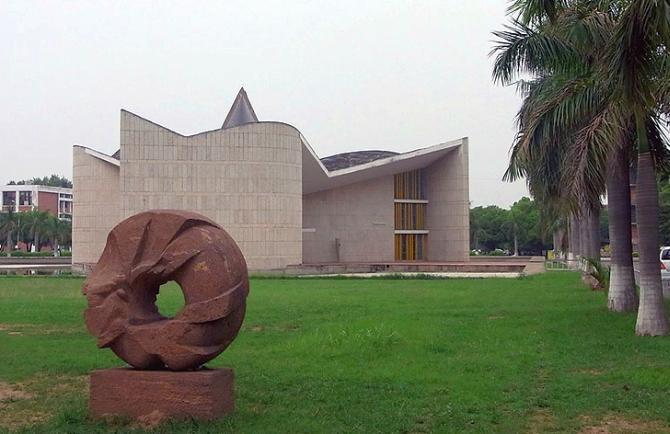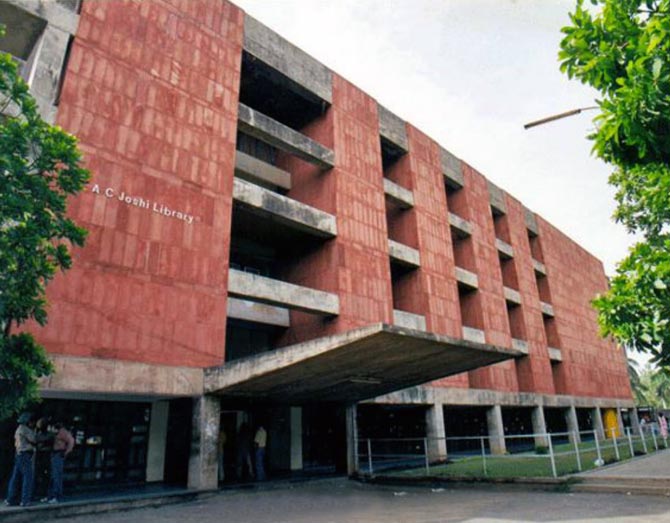 | « Back to article | Print this article |
How Panjab University made it to the world rankings
The university, once split by Partition and then rocked by terrorism, is gradually making its academic presence felt. It was recently ranked the highest Indian university among the top 400 universities in the world.
Every morning at eight, the community radio station located on the Panjab University campus in Chandigarh comes alive.
And in an instant, the university becomes part of the lives of the people who live beyond the boundaries of its pretty, flower-sprinkled campus which is spread across 2.2 square kilometres and covers two of the city's sectors -- 14 and 25.
During the course of the day, the channel, housed in the university's three-storey School of Communication Studies, plays music by local bands, broadcasts stories by local writers and interviews with experts and offers a platform to little-known talent.
Books, which are not available in Braille, are read out and recorded for the benefit of visually-impaired students pursuing higher education, and this expanding audio library is made available to them free of cost.
Through initiatives such as these, the university is slowly paying back to the community to which it owes its birth.
The story of Panjab University is intricately woven with the story of the people of the region, their tumultuous history and spirit of survival.
And in this story is hidden the reason why this university has been rated, to its own surprise, as the country's top university in the Times Higher Education World University rankings.
It's a story that began more than a century ago. And it is worth a visit.
The government of India had set up three universities in 1857 -- Calcutta, Madras and Bombay.
"About a decade later, demand arose for another university, this time at Lahore," recounts DVS Jain, professor (Emeritus) at the chemistry department and author of The Flight of the Phoenix, a biography of Panjab University. But for years, the government kept saying there was no money for it. So the people decided to raise money and give themselves a university. Local rajas, doctors, lawyers, students, shopkeepers -- all chipped in.
"Gullaks (piggy banks) were placed outside ration shops in which people would drop money," says Rajivlochan, head of the history department who has researched the University's origins.
"When these gullaks were finally opened, there was Rs 10,000 in them."
And in 1882, the institute was born, initially to promote oriental learning but soon "more practical subjects, like the sciences took over," he says.
Panjab University was India's first teaching university; the others were examining universities, which handed out degrees but did not have teaching departments.
ALSO READ: Panjab University beats IITs in global rankings
Please click NEXT to continue reading...
How Panjab University made it to the world rankings
When Partition happened, like people on both sides of the border, the university too was split.
Even the books in its library were divided into 'India' and 'Pakistan' categories.
Here in India, the university was scattered across cities, with its headquarters in Solan and teaching departments in Amritsar, Hoshiarpur, Jalandhar and Camp College, Delhi, which took its name from the nearby refugee camp.
It was at Hoshiarpur that Prime Minister Manmohan Singh was a student of the university.
He would later go on to teach economics here.
The buzz is that it was an encouraging nudge from this powerful alumnus which won the university its top rank.
It certainly got it to participate. (Incidentally, this is one of those rare occasions when both the Prime Minister and the Leader of Opposition in the Lok Sabha, Sushma Swaraj, happen to be from the same university).
But the prime minister isn't the only reason the university is where it is today in the rankings.
In the field of sciences, particularly, the university has steadily built a talent pool.
Post Independence, its research in industrial chemistry played a significant role during the industrial revolution. And now its physics department, which has 140 research scholars, has contributed in a big way to the Times ranking.
Four members of the physics faculty and 12-14 research scholars have been part of the research that led to the discovery of Higgs Boson, or God particle, which has earned Briton Peter Higgs and Belgian Francois Englert the 2013 Nobel Prize.
Manjit Kaur, chairperson of the physics department who has been working on the project for almost 20 years, says, "These were years without a summer or a winter vacation. But it's been worth it."
"In scientific research," adds Vice-Chancellor A K Grover, "recognition usually comes after decades."
Grover, a physicist, was a professor at the School of Natural Sciences in the Tata Institute of Fundamental Research before this.
Some believe the researcher vice-chancellor might have played a key role in helping the university present its case in a more organised and logical manner.
That apart, the university's score on the citation of studies conducted by its researchers was the main reason it surged ahead of the Indian Institutes of Technology in the rankings.
The university scored 84.7 per cent in citation -- higher even than the University of Tokyo which was ranked first in Asia.
All the papers produced at Europe's CERN, the lab which discovered the 'God particle', gave credit to the researchers from the university. That helped the ranking.
Research on its own fetch the university a score of only 14 per cent. The university is, however, focusing heavily in this field.
How Panjab University made it to the world rankings
Step into the chemistry department where 80 research scholars are currently at work.
Here some Indo-German and Indo-Japanese projects are under way. Aiding research work is the Sophisticated Analytical Instrumentation Facility, which houses rare instruments that are accessed by research institutes and industries from across India.
The mass communication department, which once functioned out of two-odd rooms and offered a two-year course, is now a three-storey structure that boasts of an educational multimedia research centre and has been renamed the School of Communication Studies.
"We have also started the doctorate course," says Jayanth Narayan Pethkar, its chairman.
What also worked is that unlike the IITs which are specialised institutes, the university has 13 faculties that cover different aspects of education.
However, while the university is doing significant work in the sciences, it is also a bundle of contradictions when it comes to the humanities.
"The faculty strength in history is down from 16 to six. In sociology, it has plunged from 20 to six," says Rajivlochan.
The political science department has had to shut down some of its courses.
The department of Indian theatre, which is currently undergoing renovation, is without a chairman and has a mathematician, Madhu Raka, as its officiating head. "Raka," says Grover, "is the dean of university instructions (a powerful post second only to the vice-chancellor) and has stepped in for a while." But work at the theatre department, which has 40 students and has produced actors like Anupam and Kirron Kher, is still going on.
"We start our day at 6 in the morning with yoga classes and at times work till well into the night," says Digvijay, a student from Madhya Pradesh.
Terrorism, "the critical period which Punjab went through, significantly affected the vibrant culture of the university," says SP Gautam, chairperson of the Centre for Philosophy at New Delhi's Jawaharlal Nehru University who was part of Panjab University from 1971 to 2004, first as a student and then teacher.
"During the 1980s and '90s, it became extremely difficult to recruit good people. Not many wanted to come here," recalls Jain.
It was during this time that several other institutes surged ahead of Panjab University.



